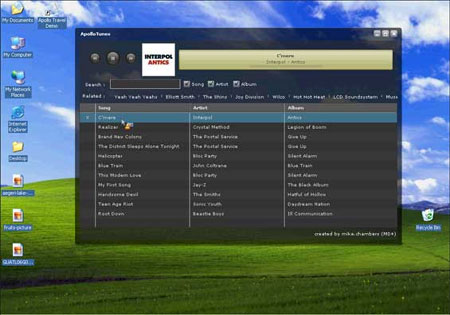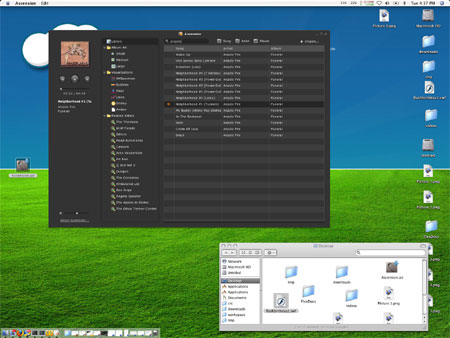For over a year and a half Adobe has been making some interesting moves that could bridge the gap between the Web and traditional desktop applications. Adobe's first move in this strategy was to purchase Macromedia, the company behind Flash and a range of Web development tools. With these technologies in stock they are now actively developing Apollo, a cross-platform desktop framework which draws together HTML, PDF and Flash to create a Web/desktop hybrid environment (refer to this technical article for details).
TechCrunch has an excellent article about Apollo and posted a podcast with Adobe's chief software architect Kevin Lynch on the subject. With Apollo Adobe will be put on a direct collision course with Microsoft in the emerging Rich-Web application arena. Alongside Vista, Microsoft are releasing their new Windows Presentation Foundation (WPF) and XML Paper Specification (XPS) technologies. WPF and XPS are Microsoft's response to the two formats that have successfully defied their monopoly on desktop file standards: HTML and PDF. WPF is part of the .Net 3.0 framework and whilst intended to replace the aging Windows graphical API a large part of it is devoted to facilitating Rich-Web applications through XAML markup (an incompatible derivative of HTML). XPS on the other hand is a direct PDF competitor and is not intended to replace any existing Windows technology rather destroy the incumbent. Usurping these entrenched standards is important to Microsoft because as history has shown controlling a standard is equivalent to holding the high ground on a battlefield; it does not automatically win you the war but it goes a long way.

An Apollo application running on Windows
What is a Rich-Web application?
Standard Web applications as we know them today do not integrate with the user's desktop and do not perform local caching (without seriously tricky hacks). These shortcomings limit what tasks Web applications can undertake, hinder the user experience when compared to their desktop-based equivalents and most importantly result in the application ceasing to exist when Internet connectivity is lost. A Rich-Web application however exists in the grey area between the Internet and your desktop. It is designed like a traditional Web application but rather than running solely on the server it is capable of integrating with the desktop (for example searching your address book) and is capable of running locally when the Internet connection goes down and can sync itself back to the server when reconnected.
Widgets and Gadgets on the OSX and Vista desktop and applications like iFolder and the iTunes Music store are conventional examples of how a Rich-Web application would perform. None of these examples are true Rich-Web applications as they follow conventional programming idioms, but they do illustrate what is possible when the grey area between Internet and desktop is utilised to the benefit of the user. Whilst no Rich-Web applications exist on our desktops just yet the platform for running them will arrive next year in the form of Adobe's Apollo and Microsoft's .Net 3.0 frameworks.
What makes Rich-Web applications important?
Rich-Web applications are important because they simultaneously reinforce the role of the desktop and exploit the potential of the Web. Whilst some have heralded the arrival of the Web as the death knell for the Microsoft dominated desktop the majority still require functionality that is beyond the capability of even the most advanced HTML/AJAX developer. For Microsoft embracing the Rich-Web is a means of protecting the vulnerable flanks of their Office and Windows cash cows. For Adobe moving on the Rich-Web front maybe their last and best chance of becoming the dominate platform, effectively pushing Microsoft into the back seat when it comes to innovation and control of the user experience.
From a user perspective Rich-Web applications are exciting because they will bring all the benefits of the Web such as connectivity and portability without loosing those creature comforts of the desktop we've grown accustomed to. As Rich-Web applications will harness the power of the native operating system they will also be able to undertake very complicated tasks such as a fully functional Office suite or even CAD application. Their Web heritage will mean they are easy to deploy whilst their roots in the desktop will enable users to seamlessly move between the online and offline worlds without any visible change.

An Apollo application running within OSX
The effect on the Architecture, Engineering and Construction industry
Adobe and AutoDesk are actively competing for the hearts and minds of AEC industry professionals as can be witnessed in the PDF vs DWF battle being raged today. What is interesting to note is that Microsoft will be actively supporting AutoDesk's DWF standard within their XPS file format and .Net framework. When I first heard this news I could not quite understand why Microsoft would even care about such a technology but in light of Apollo this move makes a lot of sense. Through their support of DWF Microsoft ensures their Rich-Web platform maintains feature parity with Adobe's.
With Microsoft throwing their support behind DWF I would not be surprised if they use their influence to get AutoDesk to produce some very interesting Rich-Web applications for the .Net platform. These will be used to demonstrate its capabilities and encourage further developers and users to adopt .Net 3.0. Whether or not Adobe reacts to this is uncertain but it would be great for the industry if they courted a competing AEC software vendor (or vendors) to utilise the Apollo platform. The power and utility of Rich-Web collaboration tools would far surpass that available today and ultimately it would be amazing but not unreasonable to suggest that even 3D modeling tools will be delivered as a Rich-Web applications (my money is on Google Sketchup to be first).
Conclusion
With Apollo the future or Web applications look very bright. Given its roots in the dominant Web technologies (HTML, PDF, Flash) it should not struggle getting developer support. Whether it can become the dominant desktop environment and wipe the floor with .Net 3.0 is another question entirely. Given Microsoft's install base there is no doubt that .Net 3.0 will be widely deployed but whether developers choose to use it over Apollo will hinge on the polish of both platforms and the ability of the respective companies to produce excellent developer tools within a highly competitive time-frame. Perhaps the telling factor in all this is where and how Google and Yahoo align themselves to these technologies. Apollo seems a natural fit for Google and an Apollo-based GMail/Google Calendar application may just tip support in Adobe's favour. However I would not put it past Google to stay neutral or even launch their own equivalent to Apollo just to make things really interesting.
